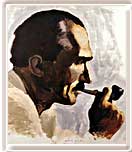 |
The political and social reality after the civil war left its deep and indelible mark on
the conscience of the intelligentsia, and was recorded in various ways in literary works.
In the field of literature three different generations coexisted. The older one (the 30s
generation, with prominent members M. Karagatsis, G. Theotokas, E. Venezis, S. Myrivilis
etc.) steered the intellectual life of the country. Some of them, such as O. Elitis with
Axion Esti and Í. Kazantzakis with his most well-known works (Christ Recrucified etc.),
created great works of art, whose impact increases as time passes by. Creators like A. Empirikos
(poet and novelist) and Í. Engonopoulos (poet and painter) continued their solitary course,
surrealism being the driving force of their art.
Beside the important literary magazines that continued to be published (Nea Estia), new
ones were created (such as Epitheorisi Technis - Art Review). At the same time a series
of other provincial periodicals was published (Kritiki and Diagonios in Thessaloniki etc.),
which proved to be centres of rally and production of cultural activity in the countryside.
The second and the third postwar generation, without negating the achievements of the previous
generations, promoted rejuvenation and often questioned the bourgeois ideology of their
predecessors. The most prominent among them were Ì. Anagnostakis, Í. Karouzos, D. Chatzis,
Á. Kotzias etc.
 |

 |


